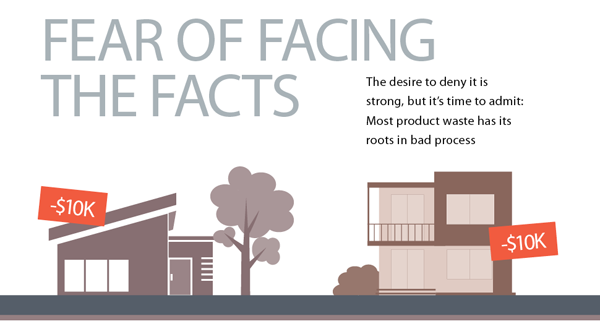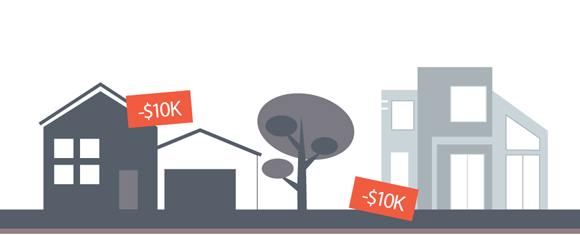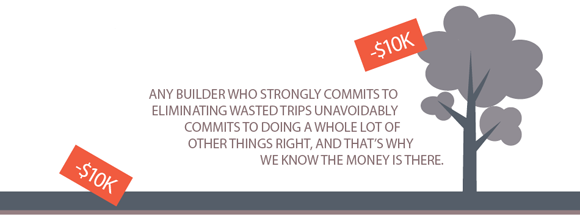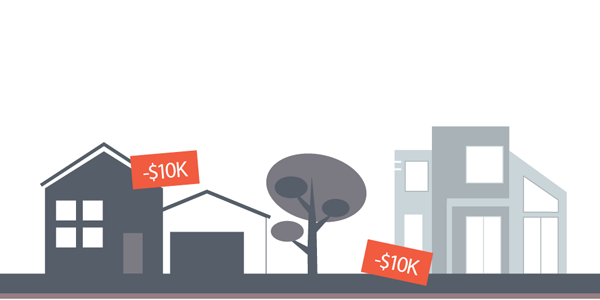Sometimes life—and work—would be easier if you could forget some things you’ve learned. Blissful ignorance has its appeal, not just for individuals but for companies, schools, churches, governments, and organizations of all kinds. Just keep on doing what you’re doing, even if it’s not working so well. Blame the suppliers, blame the trades, blame your people, blame the other builders, blame the market, blame the press, and blame the government at every level. No worries, you have a long road to travel before you get to blaming yourself.
Yet, for most of us—and I suggest for everyone who has any bent toward process improvement—once you have that piece of knowledge, know its consequences, and are banged over the head with continual reminders, you just can’t let it go.

Even more difficult is willful ignorance whereby an individual or company makes the choice to ignore what Jim Collins termed, “Objective Current Reality.” I don’t have the temper I had when I was young, and some now even describe me as patient, but encountering willful ignorance can push me right to the edge. Many times I have counseled—talked down, in effect—younger builder associates who decided to “face the brutal facts,” (another Collins saying) on difficult issues while their colleagues and bosses willfully refused. I could be the only author in history to quote Jim Collins and Cat Stevens in the same article, but during these talks, Cat’s old song “Father & Son” comes to mind with the line, “It’s not easy to be calm, when you’ve found something going on.”
This is the sixth in a series of articles in Professional Builder about process waste, how to identify and understand it, and awakening to the reality that the majority of product waste has its roots in bad process. There are hundreds of examples of process failure that seriously impede productivity and profit for builders, suppliers, and trades alike, yet there is significant resistance to tackling process obstacles head on. Going after product waste is comparatively simple. You can see it, touch it, measure it, test it. Process waste is a far bigger challenge.
A Telling Example of Waste in Home Building
To illustrate, I’ll focus on one example that I first wrote about 15 years ago and have touched on many times since, yet I see precious little awareness, shallow understanding, and virtually no change despite the veritable gold mine that awaits those who solve it. Even worse, this issue often generates fear in senior managers when confronted with it, and I’ll admit I am still trying to work out what’s behind their reaction.
Let me first suggest what their response should be. The inarguable data comes in that there is a minimum of $10K waste per unit in your homes on a single process issue. You are profitable, but at 20 percent gross margin on your $300K units, you’re not setting the world on fire. That $10K would increase your current gross margin to above 23 percent, which would make your investors very happy. You are building 100 units annually, so that’s a million bucks. You should be ecstatic, but you aren’t. In fact, you don’t even want to engage on this issue. Can you guess what this might be?
This particular $10K (minimum) that’s buried under every house in the U.S. and Canada is caused by wasted or otherwise unnecessary trips to the building site. I observed this phenomenon first in my college years, as a loader in a large commercial lumberyard in Ohio. I began to notice how one builder in particular almost never required extra trips to the sites for more materials. He got it right the first time. Three loads and done.
That builder was extremely particular about material, species, lengths, and how the loads should be stacked. For others, “hot shot” runs were a way of life. Forty years later, I’ve learned the average lumber company requires five to seven additional trips to a site beyond what should have originally been required had things gone right from the beginning. This isn’t a rough guess. We have had more than 200 lumber and material dealers participate in our LeanWeek sessions with builders, and we have the data. For these firms, the trips average about $275 each, without opportunity cost; a huge bullet that most studies calculate at about 50 percent of the raw cost.

Think about this a moment. Let’s take the average, which is six trips, at a very low calculation of $250 per trip totaling $1,500. That’s a huge amount of cost that someone has to pay for. How many times do builders go to their lumber dealers and appeal for a $200 or $300 price cut? That’s almost impossible to get these days.
But what if the builder calls the lumber company and suggests, “How about we work together this year to eliminate four of those six trips and we each pocket more than $500?” Do you think the lumber company would be interested? I have asked countless groups of builder personnel at conferences, HBA/BIA meetings, Builder 20 Groups, etc., how many could show me that they have taken the initiative to do this. I never get a raised hand. I’ve asked several groups of lumber companies how many of their builders have ever offered. Again, no one. But why? Isn’t the benefit obvious?
The average builder in the U.S. or Canada writes checks to somewhere between 30 and 60 firms in the process of building a house. The low number is for builders using a lot of turnkey relationships, but 40 is a good working number. Our data shows that the average number of extra trips runs around 1.5 per supplier/trade. Let’s be conservative and say the total number of excess trips is 50 per house total. With 4,800 suppliers and trades now having participated in our LeanWeeks, we know that the conservative average cost per trip is $200. Sure, there are $50 trips, but then there is the foundation crew that eats up $800 for a single trip, before doing any work.
Our data shows the average number of extra trips runs around 1.5 per supplier/trade, and the average cost per trip is $201. And most builders don't even realize the wasted trips are happening!
A couple of years ago we commissioned a survey of suppliers and trades and received 497 of 600 surveys back—an incredible response. When we totaled and averaged their cost per trip, it came to $201! In short, $200 is a solid number, and again, we are not counting the huge impact of lost opportunity, so it’s actually quite low in terms of real effect.
There’s no denying it. More than 50 trips at $200 each accounts for more than $10K on the average $300K home. Be honest now. Have you ever really gone after this? If you still have doubts, there’s one subtlety here that finally dawned on us after an electrician became thoroughly unplugged during one session, passionately explaining that builders don’t even realize that 80 percent of the wasted trips are happening. He described how “dry runs,” where work cannot be started or a delivery made, generate a lot of unpleasant communication. The builder hears about it at least at the field level. The insidious ones, he went on, are when a two-day rough requires a third trip to complete due to a conflict, missed delivery, etc., and he and his fellow suppliers and trades rarely say a word.
They are good soldiers. They just do it, move on, and take the hit. This “unable to complete” applies to virtually every trade, far more often than builders ever realize, and it’s not without significant cost.
I’ve asked literally thousands of suppliers and trades now what percentage of wasted trips do they ever even try to collect a trip charge. Their answer: less than 10 percent. Similarly, I ask purchasing what percentage of the extra trip charge invoices that they see are approved and paid by the builder. They also answer less than 10 percent. Ponder that. This means builders actually pay for less than 1 percent of the wasted trips to building sites. The suppliers and trades eat this $10K on every one of your homes or rather, bury it in their overhead. No matter, the costs are there.

Waste in Home Building Has a Cost. Who Pays?
So, who ultimately pays? Is this at the heart of why builders avoid confronting this critical process issue?
I’ve had several builders actually get angry with me for generating awareness of the problem. Their concern is they will suddenly get hit with all sorts of trip charges. It is true that so many suppliers and trades out there have eaten these costs for so long that they just think that’s the way home building is and never try to collect. So is that an answer? Keep them in the dark and hope they remain unaware? Do that if you are content with lower profit for you, your suppliers, and your trades.
Right now, there is no greater issue affecting builder profitability in the U.S. than trade shortages. It matters not where you live; everyone thinks they are the worst in the country. Imagine for a moment, if you worked with your suppliers and trades in earnest and over the next couple of years eliminated 80 percent of those extra trips totaling $8K of cost. What would happen? They would immediately get more profitable at the same bid price they are getting now. Several results accrue. First, they will put you at the top of their list because you have clearly demonstrated you care about their success. Second, they can bid you more closely now, knowing they won’t have extra costs to bear. Third, you’ll get their best crews, and nothing keeps you on schedule and ensures quality better than having the best crews. Finally, even beyond those three important factors, you will make a lot more money. To get it, though, you’ll have to make some changes.
Home Builders Need to Ask the 5 Whys of Lean, Then Get Started
Get a team of your strongest people together from all parts of the company—not just construction and estimating—and brainstorm a list of everything you’d have to do to eliminate these extra trips. The age-old Lean Six Sigma technique “The 5 Whys” is perfect to get you started. Let’s try it:
- Why do our suppliers and trades have to make extra trips to building sites that kill the schedule and cost them money? Because we lack complete detail on plans, options, and specifications.
- Why? Because purchasing is so far behind.
- Why? Because we never give purchasing enough time and information to get bids, contracts, and scopes done before a new project opens.
- Why? Because Product Development is always behind.
- Why? Because senior management keeps changing the product.

If a builder figured out what they were going to build and stuck with it; product development had plans, specifications, and options determined on time; and purchasing had all the information it needed for 100 percent complete bid packages and start packages, would you reduce extra trips? Would you make more money? Would they make more money? That could go in many directions. For example, in another company the root may be that Sales accepts too many late or custom change orders. In still another company, it may be a breakdown in the PO/VPO system. In still another, it could be poor scheduling practices. No matter what the source, this is a way to reduce cost and stay on schedule.
So don’t be afraid to make multiple iterations of the 5 Whys. If you need six or seven questions to get to the heart of the matter, then do it. In the first example above, I would ask: Why does senior management keep changing the product? It could be because they bought the land wrong and what they had in mind originally wasn’t working. Or because two new competitors opened down the road at the identical price point. Or it could just be that the management team can’t ever make a decision and stick with it.
Compare that to dealing with a product issue, such as whether to switch from Siding A to Siding B, or go to a higher level of carpet pad, or change the pitch of a roof. That’s easy. Process resolution is far more complex and messy. Any builder who strongly commits to eliminating wasted trips unavoidably commits to doing a whole lot of other things right, and that’s why we know the money is there. I could have made this entire point with other processes, but the wasted trip problem is the hardest to deal with that I’ve encountered. There is genuine fear in opening up to suppliers and trades and admitting that your process failures are hurting their bottom line. There is fear that if you blow it, all you’ll get is a constant stream of trip charges leading to higher cost. There is fear that you will never actually see the money you save them. All that fear adds up to a big mental roadblock. That results in maintaining business as usual and going the traditional route of trying to negotiate lower cost. In this market, I wish you luck.
Will you allow fear to keep your back turned to this critical issue? Will fear keep you from facing the brutal facts of this and other process failures? I fear you will. I hope you will not.
Advertisement
Related Stories
Business Management
How to Create a More Inclusive Workplace for Women in Construction
Consider these tips and techniques to attract and retain more women in your home building company and reap the benefits of a more diverse workforce
Business Management
AI in Home Building ... What Now? What Next?
Artificial intelligence is coming to home building. How can builders use AI in new-home construction? Start with this primer
Business Management
Ways to Improve Home Building Productivity, Part 2: Automation
Home builders can maximize efficiencies gained through simplification and standardization by automating both on-site and back-office operations








